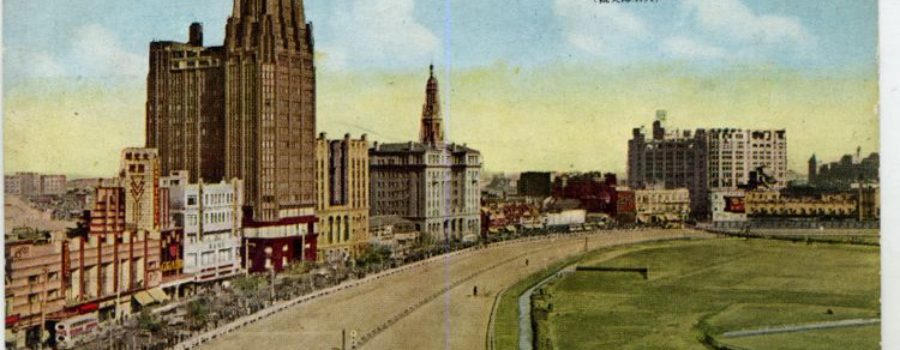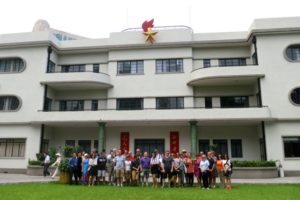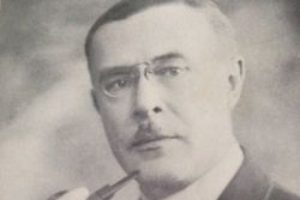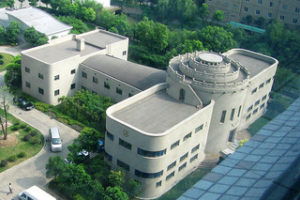The very heart of today’s Shanghai, its exact geographical centre, happens to be in the lobby of the Park Hotel. Some might say that the city’s Art Deco heart is here, too, in Laszlo Hudec’s masterpiece that once symbolized Shanghai’s modern age, and in the buildings that surround it — buildings that once defined the age of progress. The tallest, the first, the fanciest – they were all here.

The buildings around Shanghai’s old racecourse once defined progress and modernity: tallest, first, fanciest … Postcard, circa 1940.
Our July 12 Historic Shanghai Art Deco walking tour took in these iconic buildings, set in and around the racecourse that once anchored this part of the city.
This was where Shanghai played: at the racecourse, of course; in the cinemas and cabarets, at grand department stores and fancy hotels.
We began at another Hudec Art Deco jewel, right next door to Park Hotel: the Grand Theatre, built in 1933, the first air conditioned cinema in Asia. People went to the movies to escape, and architects like Hudec responded with their own form of escapism in thrillingly imaginative designs: the Grand Theatre’s speedlines and streamlined Moderne look avant-garde, even today.
In the lobby, mysterious, but very Art Deco, graphic designs are in the terrazo: what could these possibly mean? Apparently these letters, symbols, graphics, when put together, spell out LE Hudec. (We haven’t quite been able to make it work yet…)

A series of designs like this are scattered throughout the lobby. Together – apparently – they spell out Hudec.
The Park Hotel is just next door, but we crossed the street, standing in front of where the racecourse once stood, to take a good look at this dramatic structure. Built in 1934 for the Joint Savings Society, the 24-storey structure was the tallest building in Asia until 1958, and the tallest in China into the 1980s.
Its startling profile stood as witness to Shanghai history: during the Cultural Revolution, its western bourgeois façade was draped in banners proclaiming, “politics is in command!”; and its iconic silhouette was a favorite photo backdrop.
From the hotels of Nanjing Road, we crossed to the shops of Nanjing Road – once Shanghai’s Fifth Avenue, home of the best shops in the land. The Sun Department store, was one of the four great department stores of old Shanghai, all started by Australian-Chinese who wanted to bring China the tradition of Australian department stores such as Anthony Hordern and David Jones.
By all accounts, the Sun was the biggest and the most lavish, with the first escalator in China and an array of goods from around the world. Built in 1932, it was designed by a Chinese architectural firm that depicted the Sun company’s Sino-Western roots with Chinese latticework in an otherwise Art Deco façade.
A short detour, back towards People’s Square, takes us to the dynamic stepped massing of the Yangtze Hotel. Designed in 1934 by Chinese architect Paul Lin Pan, it was owned by, and catered for, elite Chinese.

A rare copy of the Yangtze Hotel’s first anniversary commemorative book, found in the Shanghai archives. Note the Guomindang flying atop the building!
The Clear Wind Jazz Band, funded by Du Yuesheng, played in its ballroom, and Yao Lee (Shanghai’s “Silver Throat”) sang the old Shanghai anthem, “Rose, Rose I Love You”. Ruan Lingyu, star of the classic Shanghai film “The Goddess”, was a frequent guest, too. Rumors had her paired with the Yangtze Hotel’s manager, and she was spotted dancing here the night before her tragic suicide.
Back on the Nanjing Road pedestrian street, we enjoy the sight of a parade of Art Deco shops. The Wing On department store’s original 1918 building is neoclassical, but its 1932 addition is a slim Art Deco tower, its shape inspired by the 1913 Woolworth’s building in New York, the tallest building in the world when it was built. The Art Deco addition housed the Great Eastern nightclub – all the big four department stores had nightclubs, the better to lure shoppers to stay – and on the seventh floor, the very fancy Seventh Heaven restaurant.
Continuing along the Nanjing Road pedestrian street are more department stores, but unlike the Big Four, these catered exclusively to Chinese clients, and were known for more competitive pricing. The Continental Emporium, built in 1932, was designed by Shanghainese architect Zhuang Jun, while the Lao Jiefu building (now the “Forever 21”), with its classic ziggurat, was particularly famous for its textiles.
A walk through the busy downtown shopping streets takes us into a quiet courtyard, and a hidden jewel: the beautiful Lester Hospital, with its Art Deco tower and details, built with an endowment in 1932 by Shanghai multi-millionaire Henry Lester. Now the Renji Hospital, it was also briefly the “Workers, Peasants, Soldiers” hospital during the Cultural Revolution.
We stroll through a maze of run-down lanes, and, for a taste of Shanghai lane life, enter what was once a glamorous old courtyard building – a hotel, said one of the residents – where old Shanghainese families live now with “new Shanghainese” – migrants. The building is a melange of East and West, Chinese detail mixing with Western design.
Our final stop is the Chekiang Theatre, a hidden Hudec gem. The three storey cinema had a rooftop terrace when open air films were shown. Slated for demolition a few years ago, preservationist activist Ruan Yisan saved it, and it remains a shabby cinema, with original details intact – but at least it stands.
Historic Shanghai’s next Art Deco Walking Tour:
Saturday, August 9 10am-12pm
The Art Deco Apartment Houses of the French Concession
RMB 200 per person, meet at the corner of Gao’an Road/Kangping Road
















Most Commented Posts